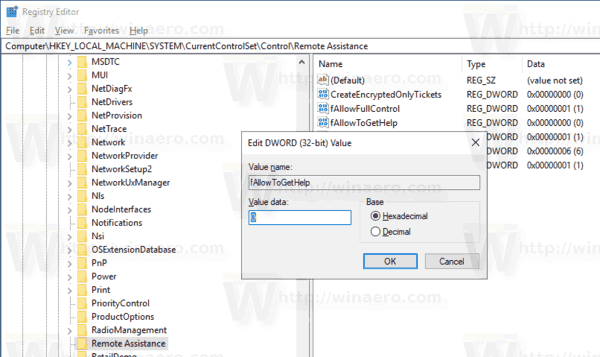You need to change the firewall rules from UI or command lines. Manually changing the Registry value is not the recommended way.If you really want to know the value of the registry when the rules are configured as your wish, please configure the rules and then check the value.Please remember to click “Mark as Answer” on the post that helps you, and to click “Unmark as Answer” if a marked post does not actually answer your question.
- Windows Registry Firewall Enabler
- Windows Registry Firewall Enable Password
- Windows Registry Firewall Enable Download
Windows Registry Firewall Enabler
Jun 11, 2019 How to enable or disable Windows Defender Using Registry Editor. Turn ON/OFF Windows Defender. Turn ON or Enable Windows Defender 1) Launch Run by pressing Win + R on your keyboard. 2) Type in regedit on the run. Jan 29, 2016 Methods to Enable and Disable Remote Desktop Locally. Added by Rick Trader January 29. Enabling RDP through the GIU will also configure the Windows Firewall with the appropriate ports to allow RDP connections. Enabling RDP through the registry will not configure the Windows Firewall with the appropriate ports to allow RDP connections.
This can be beneficial to other community members reading the thread.
CautionOnly one software firewall should be enabled at a time. If you have an antivirus or other security program installed with its own firewall, make sure it is disabled first. Click on System and Security. Click on Windows Firewall.
If the Windows Firewall is disabled, the Windows Firewall state will be Off. To turn it on, in the left, click on Turn Windows Firewall on or off. In the Customize Settings window, select Turn on Windows Firewall and click OK.Disabling the Windows 8 or 10 firewall. CautionOnly one software firewall should be enabled at a time.
If you have an antivirus or other security program installed with its own firewall, make sure it is disabled first. Click and in the Search for Programs and Files text box, type firewall and press Enter. In the search results, click Windows Firewall. If the Windows Firewall is disabled, the Windows Firewall state will be off.
If it is off, click Change settings or Turn Windows Firewall on or off in the left column. In the Firewall Settings window, select On and click OK.Disabling the Windows Vista and Windows 7 firewall. TipIf you are disabling the firewall because a program can't access your computer or the Internet, try to first. Click and in the Search for Programs and Files text box, type firewall and press Enter. In the search results, click Windows Firewall. If the Windows Firewall is enabled, the Windows Firewall state will be 'on.' To turn it off, click Change settings or Turn Windows Firewall on or off in the left column.
In the Firewall Settings window, select Off and click OK.Enable and disable the firewall in Windows XP. CautionOnly one software firewall should be enabled at a time.
Windows Registry Firewall Enable Password

Windows Registry Firewall Enable Download
If you have an antivirus or other security program installed with its own firewall, make sure it is disabled first. Open Network Connections. In the Network Connections, right-click the Local Area Connection and select properties. In the Local Area Connection Properties window, click the Advanced. Finally, check the Protect my computer and network by limiting or preventing access to this computer from the Internet option.Disabling the Windows XP firewall.
TipIf you are disabling the firewall because a program can't access your computer or the Internet, try to first. Open Network Connections. In the Network Connections, right-click the Local Area Connection and select Properties. In the Local Area Connection Properties window, click the Advanced.
Finally, uncheck the Protect my computer and network by limiting or preventing access to this computer from the Internet option.If you are attempting to disable the Windows XP firewall, but this option is already unchecked, another developer's firewall program may be installed on the computer.
Most Popular News
- Morrowind Overhaul Sounds And Graphics
- Legend Of Zelda Ocarina Of Time Enemies
- Rome Total War Mods Steam
- Skyrim Se Achievements Mod Enabler
- X Box One Gold
- Kyry Sentai Zyuranger Full Series Batch
- Company Of Heroes 2 All Units Mod Download
- Lagu Bagai Daun Kering
- Gotoubun No Hanayome Anime To Manga
- Kof 97 Dowload Pc
- How To Make Hearts Of Iron 4 Mods
- 2005 Nissan Sentra Se-r Front Grinding Noise Problems
- Sonic Generations System Requirements